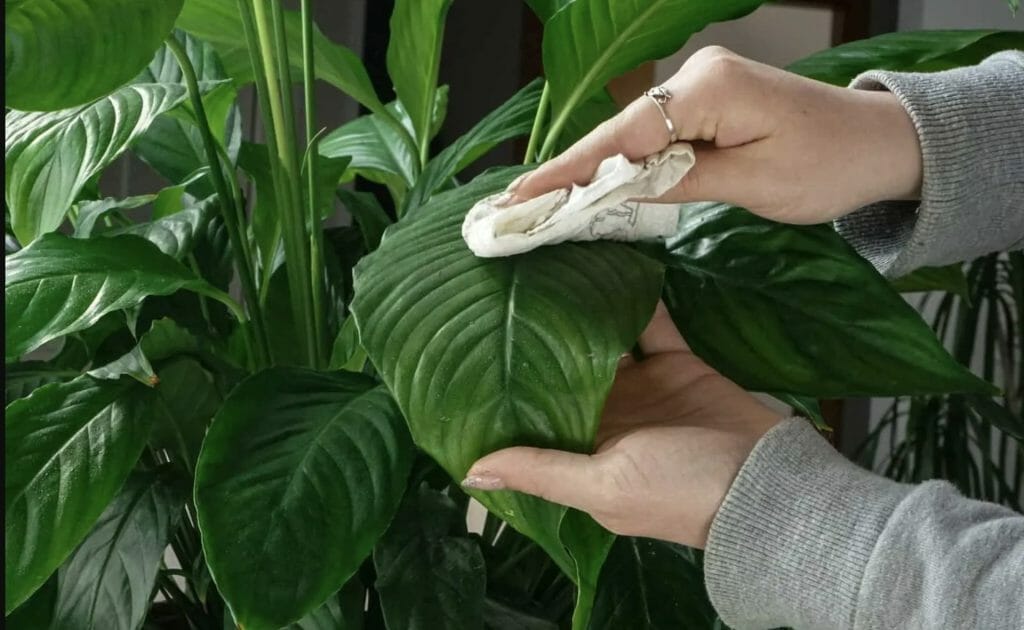The Hazards of Cleaning Plant Leaves with Olive Oil

In this blog post, we will explore the common practice of using olive oil to clean plant leaves and discuss why it can harm the health and well-being of your beloved plants.
We will explore the potential risks of this cleaning method and alternative options for maintaining clean leaves and offer practical tips for promoting plant health and longevity.
Maintaining clean and glossy plant leaves is essential to indoor plant care. While it is natural to want to keep our plants looking their best, it is important to consider the potential hazards of certain cleaning methods.
One such method that has gained popularity is using olive oil as a cleaning agent. While olive oil may seem harmless and even beneficial for humans, it can harm plants’ health.
The Risks of Olive Oil on Plant Leaves
When applied to plant leaves, olive oil can create a layer of residue that prevents proper airflow and inhibits photosynthesis. The oil can clog the stomata, small openings on the surface of leaves responsible for gas exchange. This blockage restricts the plant’s ability to take in carbon dioxide and release oxygen, vital for its growth and survival. The oil residue can also attract dust and dirt, promoting the growth of harmful fungi and bacteria.
Impaired Photosynthesis and Growth
Photosynthesis is the process by which plants convert light energy into chemical energy, producing sugars and oxygen. When olive oil is applied to plant leaves, it reduces the light that reaches the chloroplasts, where photosynthesis occurs. Reduced light absorption decreases sugar production, impaired growth, and weakened plant health. Over time, plants may become stunted, develop yellowing leaves, or even die if the issue persists.
Increased Risk of Pests and Diseases
The layer of olive oil residue on plant leaves creates an inviting environment for pests and diseases. Fungi, such as powdery mildew or sooty mold, thrive in moist conditions and can easily colonize the oil-coated foliage. Additionally, insects like aphids or mites are attracted to the sugary film formed by the residue. Infestations can spread rapidly, causing further damage to the plant and potentially leading to its demise if not addressed promptly.
Alternative Methods for Cleaning Plant Leaves
Fortunately, alternative methods effectively clean plant leaves without posing harm. One simple yet effective method is gently wiping the leaves with a damp cloth or sponge. This removes dust and dirt without leaving any harmful residue. Another option is to mist the leaves with water using a spray bottle, ensuring not to over-saturate them. Regular misting helps prevent dust accumulation and keeps the foliage clean.
Promoting Plant Health and Longevity
Aside from keeping leaves clean, several other practices can promote overall plant health and longevity. Providing adequate sunlight is crucial for optimal growth, so placing your plants near windows or using artificial grow lights can be beneficial. Regularly inspecting your plants for signs of pests or diseases allows for early detection and treatment, preventing major infestations. Proper watering techniques tailored to each plant’s needs promote healthy root development and prevent issues like root rot.
Conclusion
While olive oil may be a versatile household product, avoiding using it as a cleaning agent for plant leaves is important. The risks of olive oil residue include impaired photosynthesis, stunted growth, and increased susceptibility to pests and diseases.
Instead, use gentle cleaning methods like wiping with a damp cloth or misting with water. Adopting these alternative techniques and following best practices in plant care ensures your plants thrive and remain beautiful for years.







